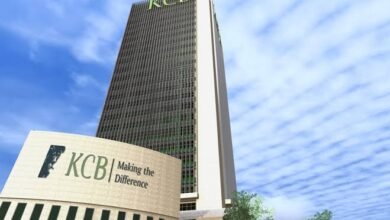
The Central Bank of Kenya has released its presentation on Kenya’s debt status that was presented before the Senate Committee on Finance and Debt.
According to the report, Kenya’s public debt to Gross Domestic Product (GDP) ratio declined from 64.1 percent in June 2003 to 38.1 percent in June 2012, but increased thereafter driven largely by spending on infrastructure and more recently, COVID-19 related spending.
External debt service to exports ratio declined from 19.2 percent in June 2000 to 3.5 percent in 2010, then rose to a high of 31 percent in June 2019.
The high ratio in 2019 was mainly on account of a one-off USD 750 million Eurobond repayment.
The ratio has been declining in the last 2 years also due to an improvement of the terms on new external loans.
Evolution of Kenya’s public debt
External Debt Service to Revenues ratio
External debt service to revenues ratio declined from 20.8 percent in June 2000 to 4.3 percent in June 2013, then rose to a high of 21.4 percent in June 2019.
The high ratio in June 2019 was mainly on account of a one-off USD 750 million Eurobond repayment.
The ratio has been declining in the last 2 years also due to an improvement of the terms on new external loans.
Total Debt Service to Revenues ratio
Total debt service to revenues increased to 57 percent in 2019 from 17 percent in 2012 due an increased debt stock and changing terms on new loans including one-off repayment of syndicated loans and Eurobonds in 2019.
This trend is expected to reverse in the medium term due to improving terms on new loans, and the restructuring of external commercial loans that have heavy maturities and high interest cost.
Composition of External Debt by Lender Category
The structure of Kenya’s external (public and publicly guaranteed) debt changed significantly between 2010 and 2020, with increased uptake of commercial debt to improve Kenya’s presence in the international financial markets to diversify Kenya’s sources of external financing.
Recent efforts to increase Kenya’s concessional public debt led to a 10.1 percentage points increase in the proportion of multilateral debt from 30.2 percent in June 2019 to 41.3 percent in June 2021.
Composition of Bilateral Lenders of External Debt
The leading bilateral lender shifted from Japan to China between 2011 and 2020.
Leading Causes of Increased Indebtedness
Increased fiscal deficit largely due to development expenditure (e.g, infrastructure) but also recurrent (e.g, education, health), and increased guaranteed debt.
Worsening terms on new loans, such as lower concessionality and increased commercial loans.
Exogenous economic shocks, such as drought or COVID-19 Overarching concern is limited capture of the returns from expenditures (investments) through increased exports, taxes, and faster economic growth.
Government Debt to GDP Ratio Trends in SSA, EMs & DCs and AEs
Government debt to GDP ratio in Advanced Economies (AEs), Emerging Markets and Developing Countries (EMs & DCs) and Sub-Saharan Africa (SSA) has been on an upward trend in the last decade.
The Sub-Saharan Africa debt to GDP ratio decreased during 2000 – 2010 as several countries in the region benefitted from Heavily Indebted Poor Countries (HIPC) and Multilateral Debt Relief Initiative (MDRI) debt relief programmes.
Recent Debt Sustainability Assessment (DSA) Assessment on Kenya
In March 2021, the IMF assessed Kenya’s public and publicly guaranteed debt as sustainable but with high risk of debt distress
Kenya’s debt was subjected to lower thresholds and benchmark during this assessment due to a downgrade in the debt carrying capacity from strong to medium debt carrying capacity majorly due to subdued world growth driven by the COVID-19 pandemic
Main factors driving this assessment were;
• high deficits from the past and the COVID-19 shock, • sharp decline in exports and economic growth caused by the pandemic
• The assessment highlighted the following as the main risks to Kenya’s DSA outlook
• Financial weaknesses in State Owned Enterprises (SOEs),
• subdued export growth,
• and economic impact of COVID-19 pandemic
Kenya’s debt sustainability is expected to improve as fiscal consolidation progresses and exports and output recover from the global shock.
Economic Consequences of High Debt Levels
It narrows the fiscal space, therefore limited resources for development and recurrent expenditure.
Narrows the fiscal buffers, thus limited space to pursue countercyclical fiscal policy leading to increased volatility and lower growth rates.
Increases the interest rate structure for the sovereign and the private sector, thus stifling innovation and productivity and eventually reducing the economy’s growth potential.
How can Kenya reduce the debt burden?
To reduce the debt burden, CBK has suggested the following;
• Stay the course on the fiscal consolidation path
• Explore non-debt creating financing options for public investments
• Increasing efficiency of public spending
• Refinancing operations; refinancing expensive debt with debt on more favorable terms
• Frequent reporting and monitoring





